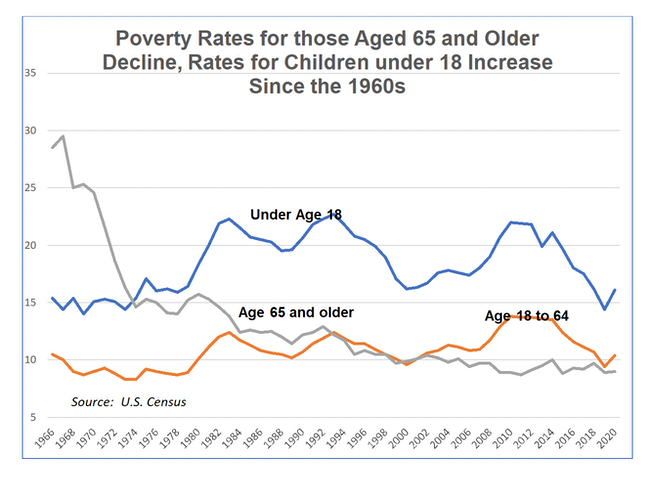 Poverty rates in the U.S. over time (Pamela Ferrara/Special to Salem Reporter)
Poverty rates in the U.S. over time (Pamela Ferrara/Special to Salem Reporter)
Government stimulus programs including expanded unemployment benefits and food stamps and payments to businesses and the self-employed helped bring some 70,000 Oregonians and 11 million people across the U.S. above the poverty line in 2020. That’s according to the Supplemental Poverty Measure and reported by the U.S. Census.
Poverty rates using this measure are estimated only for the U.S. and the 50 states. By using a ratio of Salem’s population to Oregon’s, it is estimated that the programs brought approximately 3,000 residents of Salem above the poverty line in 2020.
However, the official poverty measure showed an increase of three million more people in poverty across the U.S. than in 2019. The official measure and the Supplemental Measure estimates were reported in the September 14, 2021 Census Bureau news release.
Why are there two poverty measures, and why do they differ?
The official measure counts only money income, uses an antiquated (from 1965) definition of personal and family needs, and focuses on a food budget.
The Supplemental Measure, first used in 2011 and created as a response to criticism of the inadequacies of the official measure, counts both cash income and in-kind government benefits such as food stamps and means-tested tax credits. The list of needs is updated to include clothing, utilities and housing.
However, the official poverty measure has been in use since 1965, and has measured poverty the same way, consistently, since then. Thus, movements in the poverty rate over long periods of time can be identified.
So, we’ll use the official measure to see how our area has fared in terms of poverty.
But first, what does living in poverty mean in terms of income? Of the many combinations of families and households used by the Census to establish the official poverty threshold, here are just a few:
· A person under age 65 living alone fell below poverty with an income of $13,300; over age 65, a person living alone was in poverty with $12,261;
· A husband and wife with two children fell below poverty with an income of $25,926; with five children, they fell below poverty with an income of $38,262.
Secondly, some historical perspective. The biggest change in poverty since the end of WWII has been by age (see graph). Child poverty has increased and elderly poverty has declined. The decline in poverty for older Americans is due largely to greater availability of Social Security benefits.
Reasons for the increase in child poverty are more complicated, and have to do with changes in the economy over the years.
A child is considered poor if the adults with whom they live are experiencing poverty. And working adults today face an economy and labor market much changed from the 1960s and 70s.
The most dramatic change has been a decades-long decline in jobs in goods-producing industries (such as manufacturing) and an increase in service industry jobs, most of which don’t pay well. Good-paying jobs in both types of industries now require skills, training and education to enter. This has happened across the U. S. and Oregon.
How do these changes play out in terms of who lives in poverty?
First, a note on how to interpret poverty rates. The smaller the geography, the greater the chance that the percentage of persons living in poverty can vary, up or down, by as much as a point or so. That’s because the information is gathered from surveying a sample of the population. So, the smaller the geography, the smaller the sample, and the bigger the chance of the number not being exact.
With this in mind, overall poverty rates for Salem, Oregon and the U.S. were pretty similar for 2019 (the latest year for which detail is available). (See table)
 Across demographic groups, Salem has generally had higher poverty rates than the national average (Graphic by Pamela Ferrara/Special to Salem Reporter)
Across demographic groups, Salem has generally had higher poverty rates than the national average (Graphic by Pamela Ferrara/Special to Salem Reporter)
It’s been noted that child poverty has increased over the years, and declined in the older population. In fact, Salem’s child poverty rate for 2019 was more than twice that of the elderly.
Poverty rates by family type is where the historical changes discussed above start to make a difference. Married couple families had a poverty rate less than half of the overall rate, but marriage isn’t the reason why. It’s because there are two wage earners in half of all families, and two wage earners in 64 percent of all families with children.
Families headed by women face challenges. Some forty percent of births in the U.S. are to non-married women, up from 28 percent in 1990. One in four families headed by women were poor.
Many European countries have higher percentages of out-of wedlock births than the U.S. and lower shares of single moms living in poverty. Programs that provide subsidized day care and help for single mothers after giving birth are substantial in many of these countries, and pretty much don’t exist in the U.S.
The changing labor market over the decades plays out most dramatically in poverty rates by a person’s educational attainment. Those holding only high school degrees had poverty rates seven times those with bachelor’s degrees.
And last but not least, work does seems to be the key to staying out of poverty. But one job isn’t enough, as the poverty rate in households with only one worker was still in double digits.
So, what’s to be concluded from all this?
First, government assistance during the pandemic helped thousands of Oregonians and millions across the U.S. stay out of poverty.
Secondly, years of economic change resulting in the need for education and skills to obtain a job that pays well, and minimal safety net programs, make a difference in who is poor.
What will happen to poverty rates in 2021 and beyond as much of the aid expires? The unemployment rate in Salem dropped below five percent in August – that will help.
Census researchers are revising and improving the Supplemental Poverty Measure and at the very least, it gives a better understanding of what works and what doesn’t in terms of helping people stay out of poverty.
Pam Ferrara of the Willamette Workforce Partnership continues a regular column examining local economic issues. She may be contacted at [email protected].









